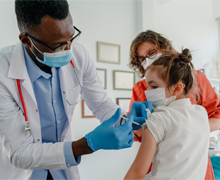Summer 2021
Helping Your Child Prepare for Vaccine Shots
 The pandemic has caused such a disruption in our daily lives and routines, many families have fallen behind on health-related tasks. If you haven’t already done so, be sure your child gets caught up on their medical and dental checkups and bring them up to date with their vaccines. Vaccines prevent diseases that can make children very sick and cause lifelong disabilities — and even death.
The pandemic has caused such a disruption in our daily lives and routines, many families have fallen behind on health-related tasks. If you haven’t already done so, be sure your child gets caught up on their medical and dental checkups and bring them up to date with their vaccines. Vaccines prevent diseases that can make children very sick and cause lifelong disabilities — and even death.
These tips will help you and your child feel calm and confident before, during and after any vaccine shot.
Babies. Breastfeeding mothers can nurse their baby during and after the vaccine. If breastfeeding is not an option, ask about giving oral sucrose during and after the shot. Cradle and talk to your baby, and perhaps distract them with a favorite toy. After the vaccine, provide lots of comforting hugs and soothing words.
Toddlers and Preschoolers. Before the day of the shot, ask about prepping with a skin-numbing cream. Just before the injection is given, tell your child they may feel a pinch that will be over quickly. Have them turn their head away from the needle, then distract them with a toy or photo. For kids ages 4 and up, teach them to ‘blow away’ the pain: have them take a long, deep breath, then blow out gently and evenly — as though blowing soap bubbles. After the shot, give plenty of praise and comfort.
School-Age Kids, Tweens and Teens. Before the day of the shot, ask about prepping with a skin-numbing cream. Calmly tell your child what’s going to happen; don’t tell them it won’t hurt or ask them not to cry. Suggest that they turn their head away from the needle, and offer other choices if possible, such as where they’d like to sit and which arm they prefer to get the injection in. Praise them for their successes, such as staying still and being cooperative. To prevent fainting (not unusual for tweens and teens after a shot), have them sit or lie down for 15 minutes afterwards.
The Pfizer COVID-19 vaccine is available for kids ages 12 and older. And by the time you read this, a vaccine may be offered (or available soon) for children younger than 12. It’s safe to get the COVID vaccine at the same time as other vaccines, according to the American Academy of Pediatrics.
If you have questions about any vaccine, be sure to ask your child’s healthcare provider.
Visit Vaccines for Your Children to learn more about vaccines, the diseases they prevent and the vaccine schedule.
Is Your Child Getting Enough Sleep?
 Sleep is crucial for the health and development of all kids, from babies to teens. Use these guidelines to know how much sleep children need at different stages.
Sleep is crucial for the health and development of all kids, from babies to teens. Use these guidelines to know how much sleep children need at different stages.
Infants ages 4 to 12 months: 12 to 16 hours, including naps.
Toddlers ages 1 to 2 years: 11 to 14 hours, including naps.
Preschoolers ages 3 to 5 years: 10 to 13 hours, including naps.
Gradeschoolers ages 6 to 12 years: 9 to 12 hours.
Teens ages 13 to 18: 8 to 10 hours.
Children who get enough sleep have healthier immune systems, plus better school performance, memory, behavior and overall mental health.
Dealing with Racial Bias
 The effects of racism are so damaging to individuals and our entire society, it is considered a public-health crisis. As parents, we must be aware of racial bias from the day our children are born. The American Academy of Pediatrics tells us that babies can notice race-based differences as early as 6 months. By ages 2 to 4, children can internalize or absorb racial biases simply by soaking in the actions and attitudes that surround them. And by age 12, kids can become set in their beliefs. This means that we have roughly a decade to shape a child’s learning process in a way that reduces racial bias and improves cultural understanding.
The effects of racism are so damaging to individuals and our entire society, it is considered a public-health crisis. As parents, we must be aware of racial bias from the day our children are born. The American Academy of Pediatrics tells us that babies can notice race-based differences as early as 6 months. By ages 2 to 4, children can internalize or absorb racial biases simply by soaking in the actions and attitudes that surround them. And by age 12, kids can become set in their beliefs. This means that we have roughly a decade to shape a child’s learning process in a way that reduces racial bias and improves cultural understanding.
Raising kids who are free of racial bias requires keen awareness, daily effort and thoughtful conversations. It starts with facing our own biases and taking steps to honor and celebrate differences among people. Since our children closely observe our actions and learn from them, it’s important that they see us interact with others in a genuinely kind and inclusive way.
Prevent Drownings with Constant Supervision
 For children ages 1 to 4, drowning is the leading cause of unintentional death, and most of these drownings happen in private swimming pools and spas. It’s understood that children must be closely supervised anytime they’re in the water. But tragically, many drownings happen when a child enters the water without being seen or heard.
For children ages 1 to 4, drowning is the leading cause of unintentional death, and most of these drownings happen in private swimming pools and spas. It’s understood that children must be closely supervised anytime they’re in the water. But tragically, many drownings happen when a child enters the water without being seen or heard.
In a typical scenario, a child wanders away from adult supervision unnoticed and enters or falls into a deserted pool or spa. So, it’s essential that pool and spa areas are fully fenced and that gates are always locked — and ideally alarmed — to keep children out. Even with these safeguards in place, constant supervision is still needed whenever there’s a pool or spa nearby; this might be at the home of friends or family, at a hotel or at a vacation rental.
Especially in group settings, at least one adult should stick with a child to ensure they don’t slip outside or wander off. Share this duty with other adults and be sure there’s a clear hand-off of duties from one guardian to the next. For large gatherings where kids will be in or near water, adults can take turns being the ‘water watcher.’
Pools and spas are not the only hazards, of course: be vigilant when you are at a picnic area or park or campsite that has a beach, lake, pond, river or stream nearby.
‘Layers of protection’ are the surest way to prevent drownings. These essential ‘layers’ include constant adult supervision, teaching children to swim at an early age, ensuring that life jackets are worn in or near the water, and being trained in CPR in case life-saving skills are needed.
Childhood Tics
 Tics are unintentional movements or sounds that are sudden, brief and repetitive. They commonly include rapid eye-blinking, facial grimaces, head movement, sniffing and throat-clearing.
Tics are unintentional movements or sounds that are sudden, brief and repetitive. They commonly include rapid eye-blinking, facial grimaces, head movement, sniffing and throat-clearing.
Childhood tics are common: up to 20% of kids may develop them. Typically, tics become apparent at age 6 or 7 and peak around ages 10 to 12. For most kids, these movements and sounds are just a nuisance, and the child simply outgrows the tics. In general, if a tic isn’t bothering your child, don’t let it bother you — and don’t draw attention to it.
If you are concerned, you can ask your child’s doctor to evaluate it. You might want to capture the tic on video to show your doctor, since it might not occur during the visit.
Read this blog post to learn more.
Tummy Time
 When infants play on their tummies, it’s a chance for them to develop their motor skills, their vision and their senses. It also strengthens their muscles, especially their neck muscles, and helps prepare them for sliding, scooting and crawling. Plus, this activity helps prevent a flat spot from forming on the back of their head.
When infants play on their tummies, it’s a chance for them to develop their motor skills, their vision and their senses. It also strengthens their muscles, especially their neck muscles, and helps prepare them for sliding, scooting and crawling. Plus, this activity helps prevent a flat spot from forming on the back of their head.
Tummy time must always be supervised by a parent or caregiver. Since it’s an active time, babies need to be fully alert, with an adult nearby to interact and encourage them.
And remember that for sleeping, babies must always be placed on their backs in their own sleep space. Cribs need a firm mattress with a tight fitted sheet — and no blankets, bumpers or soft toys.
Saying Goodbye to the Pacifier
 Babies and toddlers often stop using pacifiers on their own. If they don’t, the American Academy of Pediatric Dentistry (AAPD) recommends that parents begin weaning a child from a pacifier before age 24 months, to avoid long-term oral problems.
Babies and toddlers often stop using pacifiers on their own. If they don’t, the American Academy of Pediatric Dentistry (AAPD) recommends that parents begin weaning a child from a pacifier before age 24 months, to avoid long-term oral problems.
Start by limiting pacifier use to naptime, before bed and for stressful moments. You might also try a new comfort item, like a soft blanket with a silky edge. Always keep it positive: praise and reward your child for not using the pacifier.
Some families celebrate saying goodbye to ‘binky’ forever with a special ceremony, party or gift.
If pacifier use continues past age 3, the AAPD recommends a dental evaluation to prevent potential long-term problems.
Quick Tip
Create a system to check the back seat for your baby or toddler every time you get out of your car. Never leave a young child alone in a car.


